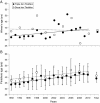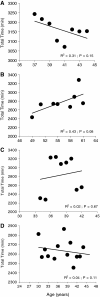Age-related changes in ultra-triathlon performances
- PMID: 23849327
- PMCID: PMC3707100
- DOI: 10.1186/2046-7648-1-5
Age-related changes in ultra-triathlon performances
Abstract
Background: The age-related decline in performance has been investigated in swimmers, runners and triathletes. No study has investigated the age-related performance decline in ultra-triathletes. The purpose of this study was to analyse the age-related declines in swimming, cycling, running and overall race time for both Triple Iron ultra-triathlon (11.4-km swimming, 540-km cycling and 126.6-km running) and Deca Iron ultra-triathlon (38-km swimming, 1,800-km cycling and 420-km running).
Methods: The age and performances of 423 male Triple Iron ultra-triathletes and 119 male Deca Iron ultra-triathletes were analysed from 1992 to 2010 using regression analyses and ANOVA.
Results: The mean age of the finishers was significantly higher for Deca Iron ultra-triathletes (41.3 ± 3.1 years) compared to a Triple Iron ultra-triathletes (38.5 ± 3.3 years) (P < 0.05). For both ultra-distances, the fastest overall race times were achieved between the ages of 25 and 44 years. Deca Iron ultra-triathletes achieved the same level of performance in swimming and cycling between 25 and 54 years of age.
Conclusions: The magnitudes of age-related declines in performance in the three disciplines of ultra-triathlon differ slightly between Triple and Deca Iron ultra-triathlon. Although the ages of Triple Iron ultra-triathletes were on average younger compared to Deca Iron ultra-triathletes, the fastest race times were achieved between 25 and 44 years for both distances. Further studies should investigate the motivation and training of ultra-triathletes to gain better insights in ultra-triathlon performance.
Figures


Similar articles
-
A comparison of performance of Deca Iron and Triple Deca Iron ultra-triathletes.Springerplus. 2014 Aug 24;3:461. doi: 10.1186/2193-1801-3-461. eCollection 2014. Springerplus. 2014. PMID: 25221734 Free PMC article.
-
Sex difference in top performers from Ironman to double deca iron ultra-triathlon.Open Access J Sports Med. 2014 Jun 26;5:159-72. doi: 10.2147/OAJSM.S65977. eCollection 2014. Open Access J Sports Med. 2014. PMID: 25114605 Free PMC article.
-
Effects of The Performance Level and Race Distance on Pacing in Ultra-Triathlons.J Hum Kinet. 2019 Jul 5;67:247-258. doi: 10.2478/hukin-2018-0079. eCollection 2019 Jun. J Hum Kinet. 2019. PMID: 31523322 Free PMC article.
-
Trends in Triathlon Performance: Effects of Sex and Age.Sports Med. 2013 Sep;43(9):851-63. doi: 10.1007/s40279-013-0067-4. Sports Med. 2013. PMID: 23797729 Review.
-
What predicts performance in ultra-triathlon races? - a comparison between Ironman distance triathlon and ultra-triathlon.Open Access J Sports Med. 2015 May 18;6:149-59. doi: 10.2147/OAJSM.S79273. eCollection 2015. Open Access J Sports Med. 2015. PMID: 26056498 Free PMC article. Review.
Cited by
-
Comparing the Performance Gap Between Males and Females in the Older Age Groups in IRONMAN® 70.3: An Internet-Based Cross-Sectional Study of More Than 800,000 Race Records.Sports Med Open. 2023 Sep 21;9(1):88. doi: 10.1186/s40798-023-00636-x. Sports Med Open. 2023. PMID: 37733151 Free PMC article.
-
Elite triathletes in 'Ironman Hawaii' get older but faster.Age (Dordr). 2014 Feb;36(1):407-16. doi: 10.1007/s11357-013-9534-y. Epub 2013 Apr 17. Age (Dordr). 2014. PMID: 23591938 Free PMC article.
-
Use of Bioimpedianciometer as Predictor of Mountain Marathon Performance.J Med Syst. 2017 May;41(5):73. doi: 10.1007/s10916-017-0722-7. Epub 2017 Mar 20. J Med Syst. 2017. PMID: 28321588
-
Change in elevation predicts 100 km ultra marathon performance.Sci Rep. 2025 Jul 11;15(1):25176. doi: 10.1038/s41598-025-09502-0. Sci Rep. 2025. PMID: 40646069 Free PMC article.
-
Participation and performance trends in ultracycling.Open Access J Sports Med. 2013 Feb 25;4:41-51. doi: 10.2147/OAJSM.S40142. eCollection 2013. Open Access J Sports Med. 2013. PMID: 24379708 Free PMC article.
References
-
- Tanaka H, Seals DR. Invited review: dynamic exercise performance in masters athletes: insight into effects of primary human aging on physiological functional capacity. J Appl Physiol. 2003;95:2152–2162. - PubMed
LinkOut - more resources
Full Text Sources

